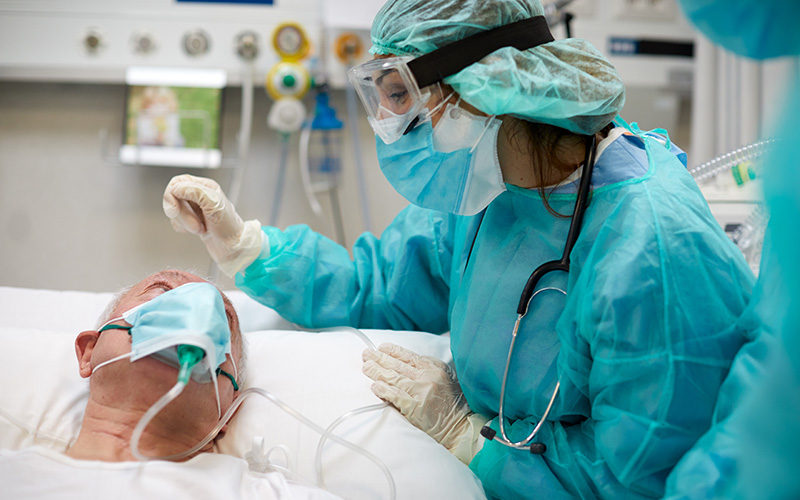The Valley Hospital found itself on the outskirts of the pandemic’s epicenter at the end of March 2020. New Jersey had the second highest number of COVID-19 cases in the country, and many of Valley’s units were dedicated to caring for these patients. By April, coronavirus patients made up 75% of Valley’s census.
Valley uses MEDITECH's Surveillance solution to monitor its patients' COVID-19 status. The hospital is one of the first and most prolific users of Surveillance, which has helped its care teams to respond to changing patient conditions, manage care, and increase compliance with quality metrics.
How Surveillance works
Surveillance uses evidence-based rules to analyze data in real time, identifying patients who meet specific criteria. Actionable surveillance boards automatically populate with qualifying patients and fit smoothly into clinicians’ workflows. Status boards and trackers throughout MEDITECH’s EHR are updated with qualified patients, expediting interventions and reducing communication delays.
Valley’s primary Surveillance specialist, Chris Neumann, said, “The solution can be used for anything, but we specifically modified it to manage our patients who test positive or negative for COVID-19, or are waiting for test results.”
Positive, negative, and pending result profiles
In the early stages of the pandemic, Valley’s IT staff built a status board to track ventilator patients who were COVID positive.
“Clinicians wanted to be able to determine how many patients had COVID-19 so the patients could be managed with the proper isolation protocols,” said Valley AVP and CAO Mike Burke. “With the number of cases skyrocketing in New York and New Jersey, we were concerned about having enough PPE and ventilators. Identifying COVID-positive patients helped us to conserve dwindling supplies for the right patients.”
According to Burke and Neumann, this status board evolved during the pandemic to identify patients with a positive, negative, or pending lab result. Using color-coded indicators, the staff can quickly see their patients’ status.
These indicators are attached to various nursing status boards and trackers throughout Valley’s EHR. The letter P, highlighted in red, displays for positive results, while the letter N, highlighted in green, displays for negative results. If test results are not yet available, a PR, highlighted in blue, displays on the board.
As the pandemic continued, Valley refined the positive profile to include patients who had been identified by Infection Control as COVID-19 positive from outside results and required isolation.
Special indicators
“We needed to come up with a way to alert clinicians about the COVID-positive test result from previous visits or other testing facilities,” explained Neumann. “Initially, we used registration queries to identify patients, but that type of query drops off the status board after the patient is discharged. So we used special indicators instead, because they’re attached to the patient’s medical record and carry over to subsequent visits.”
Valley set up two special indicators for COVID-19: confirmed and suspected. Designed to stay with the patient long term, these actionable indicators alert clinicians to “at risk” patients. Valley also uses special indicators for patients who have been tested at other organizations, using the “suspected” indicator to alert staff of potentially positive patients to begin isolation protocols. Then, if deemed positive by Infection Control, the indicator is changed to “confirmed.”
Public status boards and watchlists
Because public status boards establish a house-wide view, Valley finds them ideal for tracking COVID-19 patients. When a test is ordered for a patient who may have the coronavirus, the order qualifies the patient for the hospital’s public board. This gives the staff relevant information up front rather than checking each patient on the unit individually.
For Infection Control, Valley uses a watchlist that aggregates multiple surveillance profiles, including the three COVID-19 profiles. The watchlist displays the date and time the patient qualified for each profile, but organizations can choose to display the time since the patient qualified. Infection Control staff, nurse managers, and others can then drill down to view additional information on the profile criteria screen, which indicates the patient criteria that triggered the profile.
Recommendations for building profiles
Like most hospitals in the earliest-hit communities, Valley’s response at the beginning of the pandemic was reactionary as the organization grappled with responding to the novel disease. But now that Valley has built several iterations of COVID profiles, Neumann is in a position to offer others some valuable advice.
“In hindsight, it’s so important to ask the right questions before building your profiles,” he said. “What exactly are you tracking, equipment? Available beds? What patients are occupying those beds? We didn’t ask these questions in the beginning.”
Neumann noted that, as the situation changes, what you’re looking to track may also change. Other data items can be used as well. The patient’s portal of entry — a skilled nursing facility, for example — could be used as a criterion due to its high-risk population.
Valley continues to expand and refine its use of Surveillance to monitor COVID-19 patients. These efforts include a COVID-19 test surveillance profile.
“We’re looking to extend our surveillance profiles to look at patients tested at another location, previously tested, or not tested but in isolation,” he said. “This profile will give clinicians a more complete picture of our patients’ statuses, and help them to keep everyone safer.”

